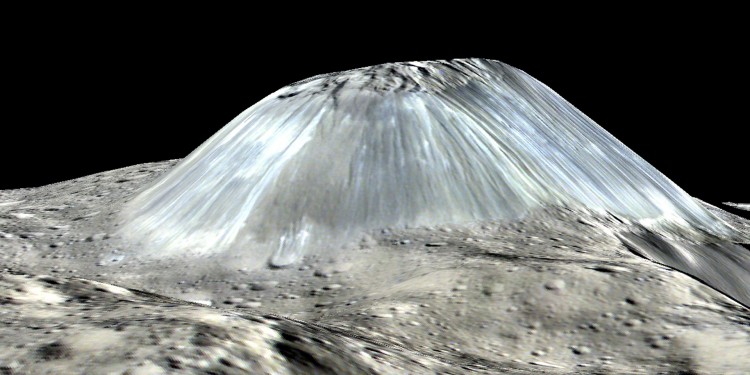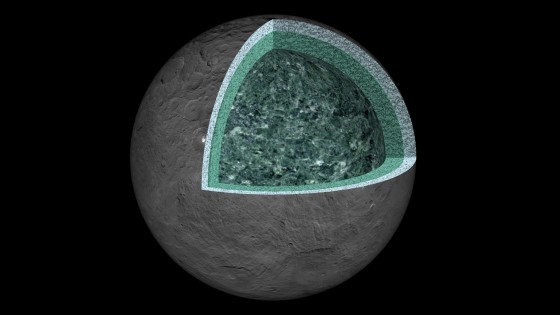
Dwarf planet Ceres: a new form of volcanism found
The scientists could hardly believe their eyes when they first saw this formation on the images acquired by their Framing Camera on board the Dawn space probe: a symmetrical mountain over 4000 metres tall and with steep, smooth sides rising over the crater-strewn surface of. It is the highest mountain on the 1000-kilometre-diameter, nearly spherical dwarf planet, and one of the most remarkable structures in the Solar System.
Now, a study involving scientists from the University of Münster and the German Aerospace Center (Deutsches Zentrum für Luft- und Raumfahrt; DLR) has used gravity measurements and investigations of the geometrical shape of Ceres to solve the mystery of how Ahuna Mons – as the mountain is called – was probably formed. A bubble containing a mixture of brine, mud and rock rose from the dwarf planet’s interior. The bubble pushed the ice-rich crust upwards, and at a structural weak point the muddy substance, comprising salts and hydreated silicates, was extruded onto the surface, solidified in the coldness of space – devoid of any atmosphere – and piled up to form a mountain. Ahuna Mons is an enormous mud volcano.
“In this region, the interior of Ceres is not rigid and solid, but viscous and, at least in parts, liquid,” explains Wladimir Neumann from the Institute of Planetology at Münster University and the DLR Institute of Planetary Research in Berlin-Adlershof. The geophysicist was involved in the study, which has now been published in the journal “Nature Geoscience”.
“This ‘bubble’, which formed in the mantle of Ceres below Ahuna Mons, is a mixture of brine and rock components,” Wladimir Neumann explains. In volcanoes on terrestrial planets, scientists speak of the ‘magma chamber’. But here, the scientists talk of a ‘cryo-chamber’, derived from the Greek word for ice, ‘kryos’. Ceres is a dwarf planet at the outer edge of the asteroid belt. It is the largest celestial body in the region between Mars and Jupiter – a zone populated by asteroids – and consists mainly of silicates, but also to a considerable extent of ice and, probably, layers of water. The scientists assume that up to one quarter of Ceres’ mass is ice or water – an even higher proportion than Earth’s reserves of freshwater and ice.
Up to a quarter of the dwarf planet Ceres consists of ice and water
The Dawn space probe’s mission began in 2007 and, after exploring the asteroid Vesta, it went on to Ceres, which it orbited between 6 March 2015 and the end of October 2018. During this time, Ceres was photographed and mapped from different heights, using two identical ‘framing cameras’ developed jointly by the Max Planck Institute of Solar System Research and the DLR Institute of Planetary Research. Many areas were captured stereoscopically so that scientists working in the field of planetary geodesy were able to calculate digital terrain models that could be used to depict the topography of Ceres’ surface.
The dwarf planet’s interior is not homogeneous but – to use geologists’ terminology – partially ‘differentiated’, which means that, after the formation of the planet, the components segregated and separated, at least partially. Those components with a higher proportion of heavy elements, such as magnesium or iron, sank into the dwarf planet’s centre, while lighter components – like rocks with a high aluminium silicate or water content – rose. Bubbles and domes formed as a result of the heat that is still being generated today – four-and-a-half billion years after the formation of Ceres – by the decay of radioactive elements. The presence of liquids influenced the development of the dwarf planet’s interior in a way that is different to that of terrestrial planets. As a result of their lower specific weight compared with the surrounding materials, these bubbles rise and press against the crust from below. The kilometre-high domes deform the crust and, once they break through it, liquid material makes its way onto the surface.
An ‘iceberg’ as tall as Mont Blanc

“To explain the formation of Ahuna Mons, we had to use a new geophysical model, specially tailored to Ceres, in order to access the information ‘hidden’ behind the data from the space probe,” explains Antonio Genova from La Sapienza University in Rome. Ottaviano Ruesch from the European Space Agency (ESA), and lead author of the study, adds: “We were thrilled to be able to find out what process in Ceres’ mantle, directly below Ahuna Mons, is responsible for bringing material to the surface. It was already suspected that Ahuna Mons was a volcano on the basis of its shape.”
Anomalies in the gravitational field reveal the mud bubble in the interior
What the data revealed to the scientists was that Ceres’s gravitational field shows an anomaly at Ahuna Mons, where the gravitational pull, which also affects the Dawn space probe in its orbit around Ceres, is slightly greater. As a result, the space probe’s speed increases a little over this location and, at the same time, its orbit is lowered slightly. This could be measured on the basis of the Doppler effect in radio communication with the space probe, as wavelengths were compressed or expanded, depending on the geometrical constellation of the radio link. “We took a closer look at this anomaly and, after further modelling, we realised that it had to be due to a bulge in Ceres’ mantle,” says Ottaviano Ruesch. “The conclusion was obvious: the mixture of liquids and rock escaped to the surface and piled up, forming Ahuna Mons.”
Cryovolcanism is widespread in the outer Solar System. This phenomenon has been observed on Jupiter’s and Saturn’s moons, and some structures on Pluto appear to have formed in this way. Ceres is the first body in the asteroid belt on which this form of extrusion has been observed. Unlike Jupiter’s moons Europa and Ganymede, or Saturn’s moon Enceladus, on which water is pushed to the surface, the ‘magma’ in the ascending bubble on Ceres is composed of a mixture of brine and mud or rock particles.
Examinations carried out on the mineralogical composition of Ahuna Mons, using a spectrometer on board the Dawn space probe, appear to confirm these findings. The results of the study show that bubbles of saltwater and rock components can form in the interior of large asteroids or dwarf planets made of silicates and ice. These bubbles rise to the surface, where they can escape. The scientists suspect that this process can occur in these bodies over long periods of time – possibly billions of years – leading to the formation of cryovolcanoes on the surface.
Original publication:
O. Ruesch et al. (2019) : Slurry extrusion on Ceres from a convective mud-bearing mantle. Nature Geoscience; DOI: 10.1038/s41561-019-0378-7
